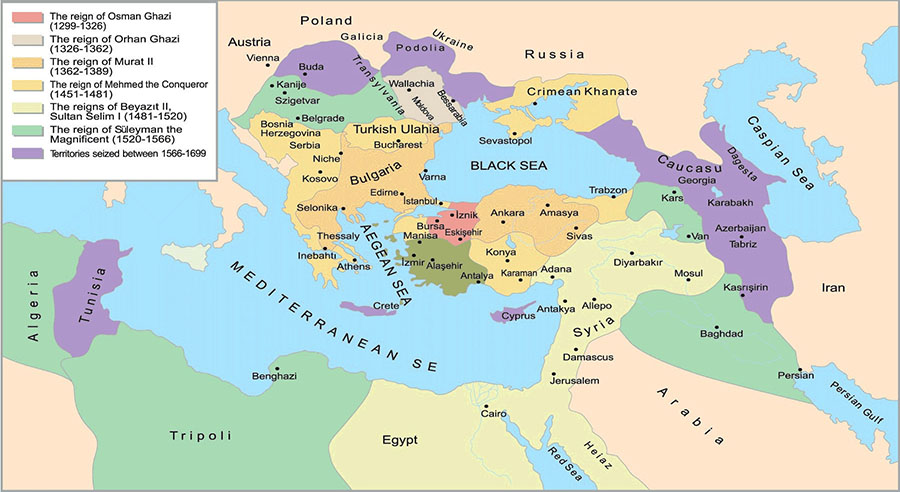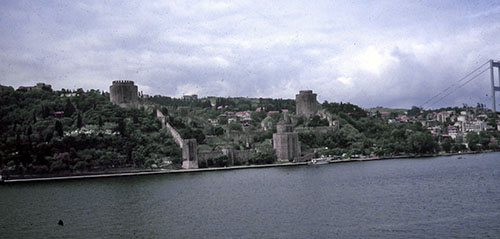Have a look at the map below to see the size of the Ottoman Empire aka "The Sublime Ottoman State"aka "The Sublime Porte" at its height; that size is very reminiscent of the extent of the Byzantine empire at its height. From a chronology standpoint, the Ottomans span the 14th to 20th centuries. That's pretty impressive run of time. Here are some of the key events in the history of the Ottoman Empire.
The dynasty that ruled the empire was founded by Osman I (died 1323?), a Turkish leader of obscure origins who controlled a small principality in the northwest of Anatolia. It is still unclear, as a result of a lack of any sources, how this particular Turkish tribe was able to expand, but the territory did continued to grow, and in 1354 soldiers crossed into the Balkans and began the conquest of the peninsula. The victory over a Serbian army led by Prince Lazar (1329-1389) at Kosovo Field on 15 June 1389 was a crucial turning point in the Ottoman campaign to control the Balkans. In the battle, both the Ottoman and Serb armies were essentially annihilated, but the Ottomans were able to call quickly on additional reserves which allowed their further conquest of territory in the Balkans.
The Ottomans slowly tightened their grip on the area surrounding Constantinople, but the city did not fall to the Turkish armies until 29 May 1453 when troops led by Mehmed the Conqueror, (1432-1481) breached the city walls. That brought an end to the Byzantine Empire, but one thing that did not end was the important state role of the Orthodox church which recognized the Ottoman rulers and, in exchange, was allowed to maintain its autonomy and land ownership.
Many scholars have considered that the empire reached its height in the reign of Suleiman the Magnificent (1494-1566). The empire continued to grow in all directions, and the city of Istanbul was at the center of key Europe-Asia trade routes. In 1526 at the Battle of Mohács, Suleiman basically assured the end of the Kingdom of Hungary, and then he turned his attention to Vienna, the capital of the Habsburg Empire, but the attempted siege failed in the fall of 1529 as weather and the exhaustion of the Ottoman soldiers proved an insurmountable combination.
Suleiman died of natural causes in 1566. He was succeed by his son Selim I aka Selim the Blond or Selim the Sot (1524-1574) What is also kind of interesting is who did not succeed Suleiman. Suleiman had six sons, four of whom made it to adulthood. One was strangled on the order of Suleiman, in Suleiman's presence. Another supposedly died of grief at the news of his brother's murder. A third, fearing for his life fled to the Safavid Empire, where he was eventually handed over to Suleiman's emissaries, for the right price, and executed.
At the end of Suleiman's reign, the Ottoman Empire was clearly the most powerful force in Europe-Asia.
Through the 1600s-1700s, the Ottomans remained a stable, powerful empire, but developments around them were changing the continued nature of Ottoman control. For example, to the north, the emergence of a powerful Russia under Peter the Great and then Catherine the Great challenged Ottoman control of the Balkans and the Black Sea. To the west, the Habsburg Empire continued its long war with the Ottomans over control of the Balkans. and further field, the emergence of sea routes to the Far East that went around Africa instead of through the Mediterranean diminished Istanbul's role in Europe-Asian trade.
The Ottomans tried one last time to remove the Habsburg threat. A Turkish army reached Vienna in 1683, but delays along the wary provided the opportunity for resistance to gather. A combined army of Habsburg, German and Polish forces led by the Polish king Jan III Sobieski (1629-1696) defeated the Ottomans. The latter fell back and were forced to sign the Treaty of Karlowitz (26 January 1699), which ended the war and which resulted in the loss of significant Ottoman territory in the Balkans.
The Ottomans suffered other military defeats in the late 18th and early 19th centuries. Internally, this prompted a series of modernizing reforms known as the Tanzimat. That included items like constitutional reforms, the introduction of secular law and the creation of a modern conscripted army. Externally, the Empire struggled to maintain its hold on the Balkans. The Serbs were the first to revolt (1804–1815), and then the Greeks followed (1821-1830). Defeat in the Russo-Turkish War (1877–78) ended with a decisive Russian victory. Bulgaria became an independent principality inside the Ottoman Empire; Romania, Serbia and Montenegro were confirmed as independent.
In 1908, a revolution in the empire was spearheaded by the "Young Turks" who hoped to replace the sultan with a constitutional government and enact modernizing reforms. The Committee of Union and Progress was able to get the constitution restored and some reforms, but then war happened.
The Ottomans cast their lot with Germany in World War I. That proved to be the wrong choice, but I'm not sure if there was any other option, as France, Russia and England had long hinted as the desire to divide up the Ottoman Empire. Defeat in the war and the ensuing break-up of the Ottoman empire was codified by the Treaty of Sèvres (1920). But opposition to that treaty and its severe territorial provisions emerged and coalesced around Mustafa Kemal Pasha (1881-1938, later known as "Atatürk"). Three years of internal civil war and national resistance against foreign occupation led to the flight of the sultan and the proclamation of the Republic of Turkey on 29 October 1923. A second peace treaty, the Treaty of Lausanne 1923, was signed which formally ended World War I hostilities. The Ottoman Empire was no more.
Here is the map of the Ottoman empire at its height.

That was a quick overview. Here are some other thoughts.
The Ottoman Empire was a conquest empire, and we know from other empires in history, that when an empire expands and conquers territory, it also conquers people. That means slaves, and those slaves can be put to work in a lot of different ways. They can farm the land; they can fight as troops in the army; they can be personal servants; they can also serve as administrators in the government.
The early Ottomans needed a lot of slaves as they expanded, and so the administration "taxed" the Christian populations of the Balkans to provide young male children. This notorious mechanism was something called the devshirme (blood tax or child levy) to supply young men (usually 8-15 years old) for service in the Ottoman military or civil service. These slave recruits were converted to Islam and given formal training and education. This practice was in effect roughly from maybe 1400 to about 1700. Some websites
- Christian Responses to the Devshirme System
- How did devshirme/recruit system of the Ottoman Empire worked: myths and truths about it
Many of those taken in the devshirme wound up in the elite Ottoman military unit called the janissary corps. The enslaved young Christian boys received military training, converted to Islam and became the sultan's personal bodyguard. For centuries, these were the empire's elite troops, and they became very powerful, but because of their power they eventually became a reactionary force that hindered the modernization of the army. The janissaries also became less dependent on enslaved Christians for manpower, and admission was opened to others. In 1826, frustrated with the janissary's opposition to reform and their reactionary political power, the sultan eliminated the janissary corps. Some websites
- The Kapıkulu Corps and Janissaries
- Janissaries: Origins and Military System Of The Elite Soldiers
- The janissaries: 14th - 19th century
Last, let's point to the important role of eunuchs in the Ottoman Empire. Eunuchs are simply castrated men, and there were different methods of castration and different physical extents of the castration. Eunuchs were relatively common in some ancient empires, like in China, and they were typically employed to guard the royal women's quarters. In the Ottoman Empire, eunuchs were typically black slaves imported from Africa or white slaves from the Balkans. Wikipedia has information about the chief white eunuch (the kapi agha) and the chief black eunuch (the kizlar agha). Some of these eunuchs became very powerful individuals by the eighteenth century, mostly because of their proximity to the mothers of the sultan's children. Some websites
- The eunuchs of the Ottoman Empire, the black castrated slaves tasked to guard bedroom doors of royal women
- Jane Hathaway, The Chief Eunuch of the Ottoman Imperial Harem
- HAREM, AND THE OTTOMAN WOMEN
![]()
References
- Wikipedia entry on the Ottoman Empire
- Ottoman Empire Text Archive at the University of Washington
- The Ottomans.org
- Ottoman Empire (History.com)
- Ottoman Empire (1301-1922) (a BBC website)
- Why the Ottoman Empire rose and fell (National Geographic)
- The New York Times has a topic list for the Ottoman Empire
- The Greater Ottoman Empire 1600-1800 (the Met timelines of art history)
